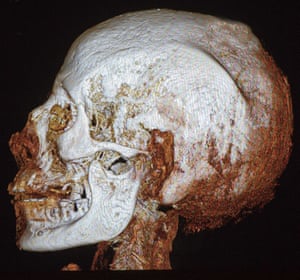
The afflictions, discovered using a CT scan, indicate that during his lifetime the man was largely sedentary, avoided manual labour in the sun and probably ate a carbohydrate-heavy diet.
The mummy is the only such relic in Israel, named the Protective Eye of Horus after a pharaonic deity. It was kept for decades at a Jesuit institute in Jerusalem before it was loaned to the Israel Museum. It will be displayed in a museum setting for the first time, from Wednesday.
The research on the mummy builds on previous international studies that have shown that people in ancient Egyptian times suffered from more recent conditions.
“Osteoporosis is a disease that is characteristic of the 20th century, when people don’t work so hard. We are glued to screens,” said Galit Bennett, who curated the mummy exhibit. “We were very surprised that there were people who didn’t do physical work and that it affected their bodies like this man here.”
A CT scan of the mummy’s head Photograph: Ariel Schalit/AP

Researchers studied the mummy’s remains earlier this year using a CT scanner, technology that allowed them to discover osteoporosis and tooth decay, and determine the mummy was a man who lived to what was at the time a relatively old age of between 30 and 40 years. He was originally 167cm (5ft 6in) tall but either during his lifetime or afterwards, he had shrunk to 154cm. His apparently sedentary lifestyle, as well as inscriptions on his coffin, indicated he was a priest, the museum said.
The museum said the mummy was originally from Akhmim, about 300 miles south of present-day Cairo. It was given as a gift to the Jesuit Pontifical Biblical Institute in Jerusalem in the late 1920s by Jesuits in Alexandria, Egypt. The mummy – nicknamed Alex – was encased in a gold and black coffin and wrapped in strands of linen, a gold mask placed on top of its concealed skull.









0 comments: